Unlike most sports, running, at its core, is pretty simple. You don’t need to study any rules before you can start and it doesn’t involve complicated skills like learning how to swing a bat, ice skate or throw a ball.
However, while running is easy to get started, that doesn’t mean you can ignore learning proper running technique and form.
Despite the fact that running is an activity most of us have done in some manner or another since we were kids, very few runners have a “perfect” natural stride. Perhaps your arms crisscross your torso instead of moving straight forward and back. Or, maybe you don’t exhibit proper hip extension by generating power from your hips and glutes.
Whatever your specific form deficiency may be, your chance of injury is dramatically increased unless you can slowly correct your technique flaws as you intensify your training.
Shouldn’t improving my form be simple?
The difficulty in changing form is that there is no absolute “perfect” running style you can copy.
While we do know the basics of what good running form should be, how that looks for each runner will be quite different. To that extent, improving your running technique isn’t about mimicking another runners form. The “perfect” form for you is one that allows you to train injury-free month after month, year after year.
In addition, changing your running form is a difficult endeavor.
The most complicated factor is that no one aspect of your running form occurs in isolation. For example, changing the position of your footstrike impacts your hip flexion, cadence, stride length and almost everything in the biomechanical chain. As such, you need to keep the entire body in mind if you plan to make changes to your form.
So how can I begin to improve my form if it’s so complicated?
Despite the fact that running form is an interconnected and dynamic series of movements, I find that breaking down the specific elements of proper biomechanics can be an effective way to teach a runner how run more efficiently.
By breaking form down into isolated, specific sections, you’re able to focus on one element at a time (your hip extension for example) without confusing yourself with everything else going on in the kinetic chain (your arm swing for instance).
To that end, performing a series of running drills a few times each week can be a great way to improve your form – if not entirely from a physical or mechanical perspective, but at least to have a better cognitive awareness of what proper form should be.
What are running drills designed to do?
Running drills are designed to mimic the specific characteristics of technically sound running form in short, compartmentalized sections.
This includes upright posture of the core and upper body, proper carriage of the arms during the running stride, proper hip extension and leg action, and the coordinated, dynamic balance associated with shifting weight from one leg to the other.
In addition, drills help to develop the important proprioceptive (body awareness) abilities that a runner must have to deal with changes in terrain while running, and to ”change gears” while training or racing.
Finally, drills also strengthen the specific muscle groups needed for powerful running, especially the muscles of the feet, calves, shins, glutes and hips. The ankle, knee and hip joints undergo considerable flexion and extension during the running stride, and each of these joints is exercised through a similar or greater range of motion during various drills
What drills should you do?
The following is a series of four of the more important running drills you should perform.
- Start slowly at first while developing a “feel” for proper technique. As you get more comfortable, gradually begin to increase your speed so you’re working through each movement quickly.
- Perform these drills two to three times per week after an easy or long run.
- Start with 25-30 meters and progress to 75-100 meters as you gain comfort with the movements.
‘A’ March/SkipDrill
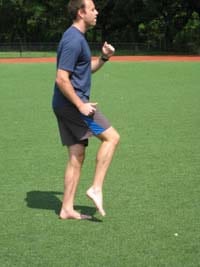
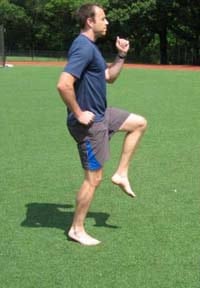
Value for runners: The marching ‘A’ drill emphasizes proper running mechanics – a driving knee lift, upright posture and a coordinated arm swing – and is the introductory drill.
Logistics: Begin by walking slowly forward on the balls of your feet using small (12 to 18 inch) steps. Your heels should not touch the ground during this exercise. Continue by raising your right knee to hip level (with thigh parallel to the ground) on each stride. Your right foot should be “cocked” (making your ankle and foot look like a fishhook) at the top of the leg swing, and your right ankle should be directly under or slightly behind your right knee (your knee should be at a 90 degree angle or slightly less).
Rise on the toes of the left foot, extend the left ankle and knee as your body passes over the left foot during the walking stride. Your trunk should be held upright (think “chest tall and slightly forward”), and your chin should be held level.
Swing your arms slowly and deliberately in a mock running motion in rhythm with the marching/walking strides.
Repeat this action, raising the left knee to hip level with the left leg moving through a normal walking stride into full extension on the toes, for 20 to 40 meters.
All of your movements should occur in a slow and controlled, not jerky manner. Once you’ve mastered “marching” you can add the skip by skipping forward instead of marching.
‘B’ March/Skip Drill
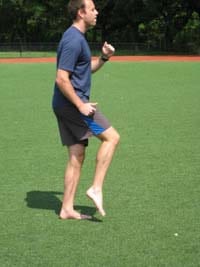

Value for runners: The ‘B’ drill emphasizes hamstring flexibility and body control, improving coordination and balance and upgrading running posture. In addition the skipping ‘B’ drill stresses the development of an active foot strike, providing the basis for improved stride length.
Logistics: The “b” skip is performed in the same manner as the “a” skip except you drive your leg out and back as opposed to keeping it bent at a 90 degree angle. Start with 25 meters of marching. Once this feels comfortable and balanced, perform 25 meters marching and 25 meters skipping. The marching should always proceed the skipping. Progress all the way to 75 meters of both marching and skipping.
Straight leg bound

Value for runners: The straight leg bound increases your ability to generate power from the hips, hamstrings and glutes stride length. The motion emphasized in this drill will help improve explosive power during the running stride.
Logistics: Run forward by keeping your legs straight and driving through the ground with your hips and glutes. Begin by running 50 meters. Progress until you’re running 100 meters.
G-Drill
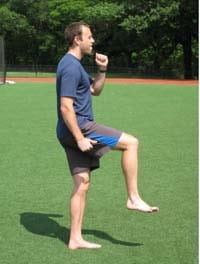
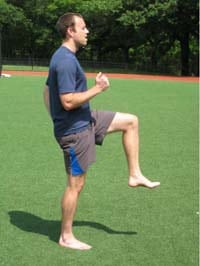
Value for runners: Improves balance, coordination, and significantly increases cadence or stride frequency.
Logistics: Balance for 10 seconds on each leg and then hop to the next leg while cycling your leg in a running motion. Once 10 seconds is comfortable, balance for 5 seconds. Perform 10 repetitions on each leg.
If you’re interested in learning more about how to improve YOUR own running form, signup for personalized video form analysis and 6-week online form course. The video analysis and course will provide you with a personalized, simple-to-follow, progressive set of exercises, drills and mental cues to help you make lasting changes to your form. Click Here to Get Yours Now!





2 Responses
Nice article. Your model in the pictures is doing them wrong. Doesn’t the elbow go back when the knee is up on the same side?
Yes, you are correct. I chose bad images that don’t lineup well since adding the full sequence would have taken too much space. I’ll have to correct this. It’s easier to see in the video these screenshots were taken from.